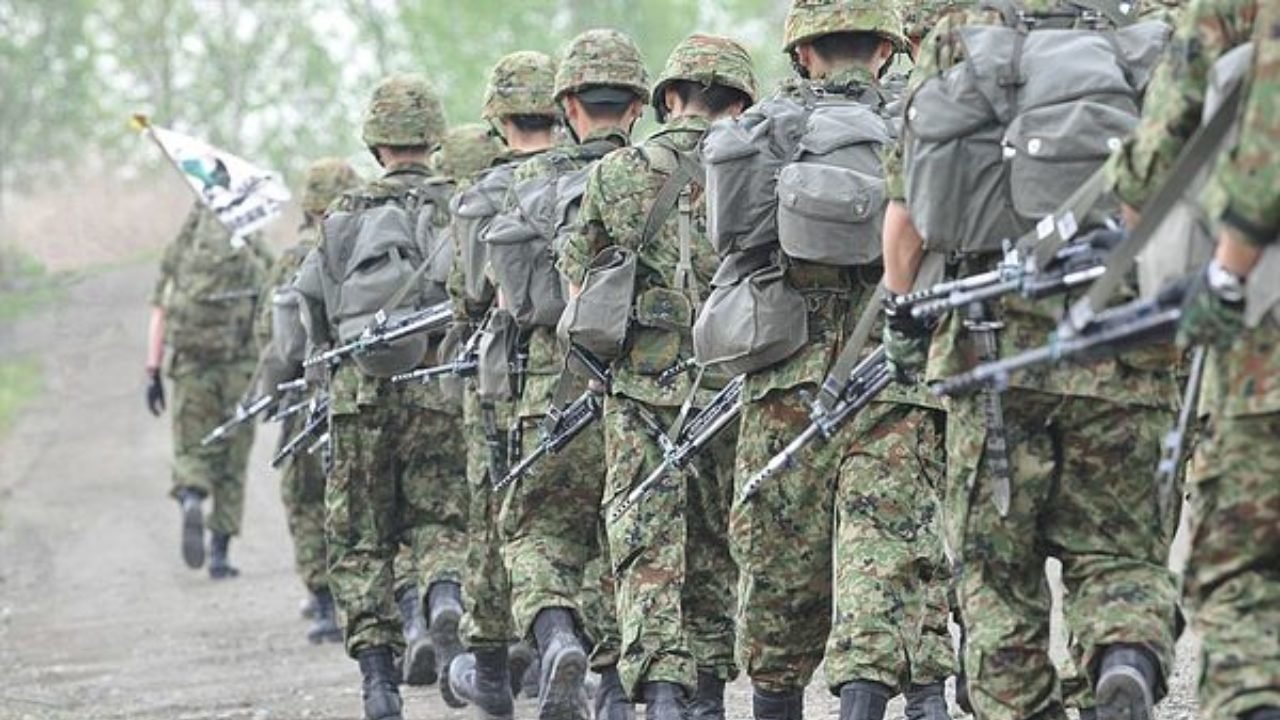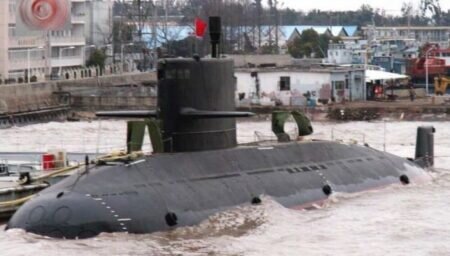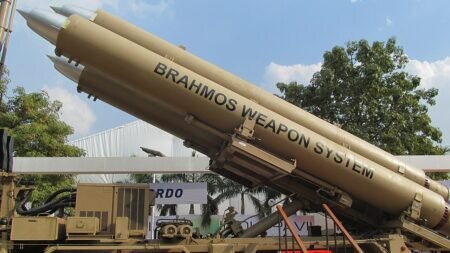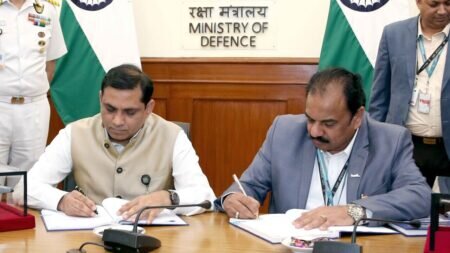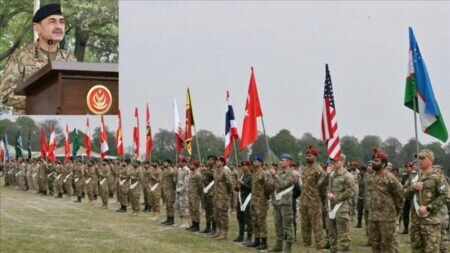Strategic experts in India and Pakistan have urged both countries to strengthen military-to-military confidence-building measures (CBMs) to avoid the recurrence of an "accidental" firing of missiles.
At a time when the world was still grappling with fighting between Russia and Ukraine, war clouds nearly hovered over South Asia on March 9, once an Indian nuclear-capable cruise missile, launched “accidentally,” landed in neighboring Pakistan.
Although better senses prevailed, reports said Pakistan had almost decided to retaliate, with Foreign Minister Shah Mahmood Qureshi saying the consequences would have been "very serious."
The Indian air force fired the BrahMos medium-range cruise missile from Ambala city in northern Haryana province, about 200 kilometers (124 miles) from the capital New Delhi. Pakistani authorities claimed that the missile, which was without a warhead damaged some residential property but caused no casualties.
The Pakistan air force said it tracked the flight path of the missile from Sirsa in Haryana, when it was 151 km (93 mi) away from the border before it landed some 124 km (77 mi) inside Pakistan’s territory in the Mian Channu city "in 3 minutes and 44 seconds," said Pakistani military spokesperson Maj. Gen. Babar Iftikhar.
The Indian government said the accidental firing took place because of a "technical malfunction in the course of routine maintenance."
Even as Defense Minister Rajnath Singh said India is reviewing standard operating procedures for operations, experts believe that the incident has cast reflection on the safety and security of missile systems in India.
Ties between India and Pakistan are at a historic low since 2019 when India launched airstrikes in Pakistan's Balakot, followed by an aerial dogfight between the neighbors. Since then, both sides have kept their arsenal at "a high state of readiness, capable of being operationalized and released within seconds or minutes."
Opportunity for both countries
Tara Kartha, who served at India’s National Security Council Secretariat for 17 years, said the accident may provide an opportunity for both countries to review the entire gamut of safety procedures to ensure a high degree of confidence.
“This misfiring could then lead India and Pakistan to show the world that both are made of better stuff than the fire-breathing dragons on the loose in Europe,” she said.
According to an agreement signed by both countries in 2005, it is mandatory to provide a three-day notice for testing a ballistic missile. Also, they will not test their arsenal at the geographical proximity of the borders, to ensure that the trajectory of the missiles does not cross to the other side.
Ironically, the agreement excludes providing notification about cruise missiles.
When the negotiations for inking the agreement started in 1999, Pakistan did not possess cruise missiles. Those who have been part of the negotiations said that despite many attempts, the Indian side was adamant to limit the notification to ballistic missiles only.
Interestingly, within days of the signing of this agreement, Pakistan tested its first cruise missile Hatf-VII, demonstrating its capability.
Cruise missiles, in contrast to ballistic missiles, are self-propelled guided missiles that can travel at low altitudes along pre-programmed flight paths, making them harder to detect.
The missile test data compiled by the US-based James Martin Center for Nonproliferation Studies shows India and Pakistan have been investing heavily in cruise missiles. In India, cruise missiles account for about 19% of all missile flight tests since the first recorded flight test of the BrahMos in 2001. They account for about 30% of all Pakistani flight tests since it unveiled its first cruise missile in 2005.
In contrast, Iran and North Korea have conducted less than a dozen cruise missile tests.
In a research paper, Shea Cotton and Anne Pellegrino, both research associates at the James Martin Center, believe that oversight of cruise missiles is more concerning in the context of the rising perception of cruise missiles as an important strategic capability and the growing fear that all cruise missiles are technically nuclear-capable.
Need to expand notification regime
Cotton and Pellegrino argue that since the cruise missiles are just as dangerous and destabilizing as ballistic missiles, India and Pakistan should expand the 2005 pre-launch notification regime to include cruise missile tests.
"A move like this may seem like a small step, but given the complex and sometimes confusing role cruise missiles play in both arsenals, it could go a long way to defining clear norms and limiting one avenue for misunderstanding and miscalculation. With the potential for a catastrophe, small measures can make big differences," said the two researchers.
Speaking to Anadolu Agency, retired Lt. Gen. Satish Dua, who has commanded the Integrated Defence Staff -- a unit coordinating different branches of the Indian army -- said there was a need to add military-to-military level bilateral contacts.
Both countries have a lone military contact in the name of a hotline between the two directors general of military operations. Dua said it was not sufficient and there was a need to have field commanders' level contacts to avoid any escalations.
He said military CBMs have worked well with China and they did not allow firing of a single shot over 50 years in the region, despite the recent standoff.
“For half a century, no bullet was fired there. The 2020 incident with China also stabilized due to military-level contacts. Similar border personnel talks need to be on the Pakistan side as well. Besides DGMO (Director General of Military Operations) talks, we need to add field-level mechanism as well, as we have with China,” he said.
India’s former intelligence chief Amarjit Singh Dulat said there should be no hesitancy to even arrange a meeting between the two army chiefs to build a better understanding. But he said it was only possible when political leaders of both countries start negotiating in an atmosphere of trust.
Earlier misses
Sources in New Delhi said that in 2009 as well, the BrahMos had missed the target at the testing range at Pokhran in Rajasthan because its global positioning system (GPS) blanked out.
The Frontline journal, quoting Defense Research Development Organisation (DRDO) officials, said that when the test was being conducted, far away in Washington, Barack Obama was being sworn in as the US president. The US-based satellites had switched off the GPS.
The missile, therefore, traveled for 112 seconds instead of the slated 84 seconds and fell 7 km (4.3 mi) away from the target.
The officials could not say whether the Americans had deliberately switched off the GPS satellites to test whether India’s missile mission would be a success without them.
Last year in July also, the missile failed during a test firing off the coast of Odisha in the Bay of Bengal. The extended range of the missile was being tested to hit up to 450 km (280 mi). But the missile fell off very shortly, sources told Indian news agency Asia News International.
In response to India’s BrahMos cruise missile, Pakistan launched Babur Cruise Missile IA, twice during the year with a range of 450 km, according to data collected from the Pakistani army's public relations website.
BrahMos, jointly developed by India and Russia, is essentially an anti-ship missile, which can travel three times the speed of sound. Originally, it was supposed to hit a target 290 km (180 mi) away, but its new variants can now hit up to 450 km.
According to a former DRDO official, who did not want to be named, said it is perhaps the only missile in the world that can hit targets both in the sea and on land, without any change in its hardware -- only the software to be changed.
History of military confidence-building measures
Tracing the history of military-to-military CBMs between the two nuclear-armed countries, American scholars Michael Krepon and Amit Sevak have documented that the two armies, despite hostilities, had entered into an arrangement during the 1965 and 1971 wars to avoid the bombing of civilian areas.
"A border dispute and subsequent skirmishes in the Rann of Kutch, in the western Indian state of Gujarat, had preceded the 1965 war in Kashmir. As the hostilities escalated, then-Indian Air Marshal Arjan Singh called on his Pakistani counterpart Air Marshal Asghar Khan and (they) reached an informal agreement of not using their respective air forces in the open, desert-like area of Kutch. This move was done to protect the infantry, that was without any natural cover, and the mechanized armor from airstrikes," wrote the scholars.
A similar kind of agreement was made when both sides refrained from bombing each other's population centers, dams, and irrigation facilities during the 1971 war.
According to Jyoti Pathania, a senior fellow at the Centre for Land Warfare Studies -- a new Delhi-based military thinktank -- the military CBMs between the two countries have proved to be more pragmatic than mere idealistic in their approach and functioning. She cited the holding of cease-fire along the Line of Control in Jammu and Kashmir over more than a year, despite the hostility between the capitals.
She said there was a need for measures like a regular bilateral military delegation exchange to focus on areas such as conflict prevention, misperception, and damage limitation in case of a conflict.
"Otherwise, the chances of inadvertent or accidental use of nuclear weapons could increase, which has the potential to cause a nuclear Armageddon in the region," she added.
It seems that military CBMs will always remain necessary as both countries continue to be in tension, due to unresolved political issues and frequent provocative troop movements and military exercises near the tense borders.
Therefore, the political and security realities of the Indian and Pakistani strategic environment demand a realistic, long-term, and holistic approach, for successful implementation of military and well as political CBMs to build trust and then move to settle the difficult issues.
By Iftikhar Gilani
- The writer is a senior journalist at Anadolu Agency

